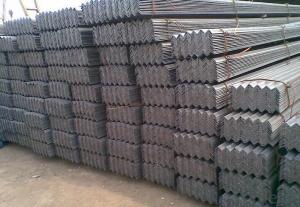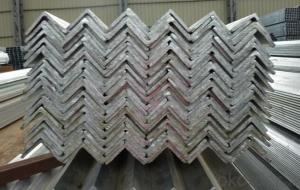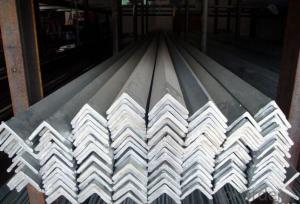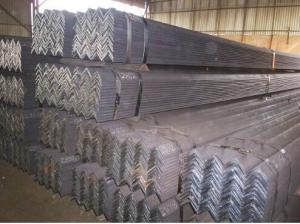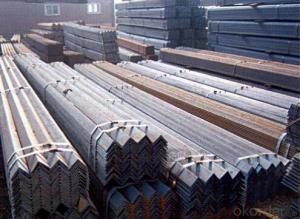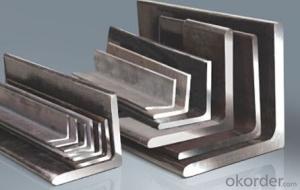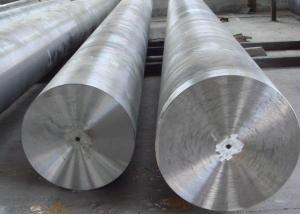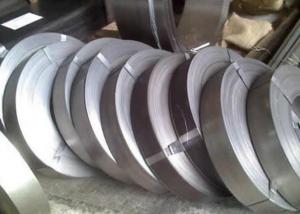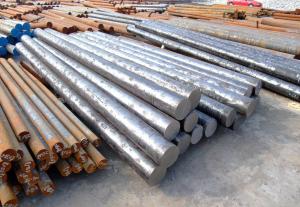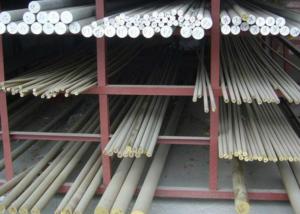Equal-Unequal Grade CNBM Black & Galvanized Steel Angle Bar
- Loading Port:
- Tianjin
- Payment Terms:
- TT OR LC
- Min Order Qty:
- 3 m.t.
- Supply Capability:
- 10000 m.t./month
OKorder Service Pledge
OKorder Financial Service
You Might Also Like
Item specifice
Equal-Unequal Grade CNBM Black & Galvanized Steel Angle Bar
Detailed Informaion
Name | Equal/Unequal Angle Steel Bar |
Shape | Equal/Unequal Angle |
Standard | GB/ASTM/SAE/AISI/DIN/JIS/EN/BS |
Surface Treatment: | Black/Peeling/Polished/Machined |
Delivery Condition: | Hot Rolled or Forged/Peeled or Black Surface |
Test | SGS/UT 100% Elements Testing |
Certificate: | ISO/Mill Certificate |
Service: | 24 hours online service / |
more than 20 years trading and manufacture | |
Quality Assurance: | the third party inspection, such as SGS, BV, TUV…etc. is acceptable |
Packaging Details: | Seaworthy Packaging or as per customer's packing instruction |
Specification
size A*B | size allow-able deviation | thickness | |||||||||
3 | 4 | 5 | 6 | 7 | 8 | 9 | 10 | 11 | 12 | ||
thickness allowable deviation | |||||||||||
25*25 | ±1.5 | ±0.5 | ±0.5 | ±0.5 |
|
|
|
|
|
|
|
30*30 | ±2.0 | ±0.5 | ±0.5 | ±0.5 | ±0.5 |
|
|
|
|
|
|
40*40 | ±2.0 | ±0.6 | ±0.6 | ±0.6 | ±0.6 |
|
|
|
|
|
|
50*50 | ±2.0 | ±0.6 | ±0.6 | ±0.6 | ±0.6 |
|
|
|
|
|
|
60*60 | ±3.0 |
| ±0.6 | ±0.6 | ±0.6 | ±0.6 |
|
|
|
|
|
65*65 | ±3.0 |
|
| ±0.6 | ±0.6 | ±0.7 | ±0.7 | ±0.7 |
|
|
|
70*70 | ±3.0 |
|
| ±0.7 | ±0.7 | ±0.7 | ±0.7 | ±0.7 | ±0.7 |
|
|
75*75 | ±3.0 |
|
|
| ±0.7 | ±0.7 | ±0.7 | ±0.7 | ±0.7 |
|
|
80*80 | ±3.0 |
|
|
| ±0.7 | ±0.7 | ±0.7 | ±0.7 | ±0.7 |
|
|
100*100 | ±4.0 |
|
|
|
| ±0.7 | ±0.7 | ±0.7 | ±0.8 | ±0.8 | ±0.8 |
Company Introduction
CNBM International Corporation is the most import and export platform of CNBM group(China National Building Material Group Corporation) ,which is a state-owned enterprise, ranked in 270th of Fortune Global 500 in 2015.
With its advantages, CNBM International are mainly concentrate on Cement, Glass, Iron and Steel, Ceramics industries and devotes herself for supplying high quality series of refractories as well as technical consultancies and logistics solution.
Packaging & Delivery
Packaging Detail | Sea worthy packing /as per customer's packing instruction |
Delivery Detail | 15 ~ 40 days after receiving the deposit |
Product Show
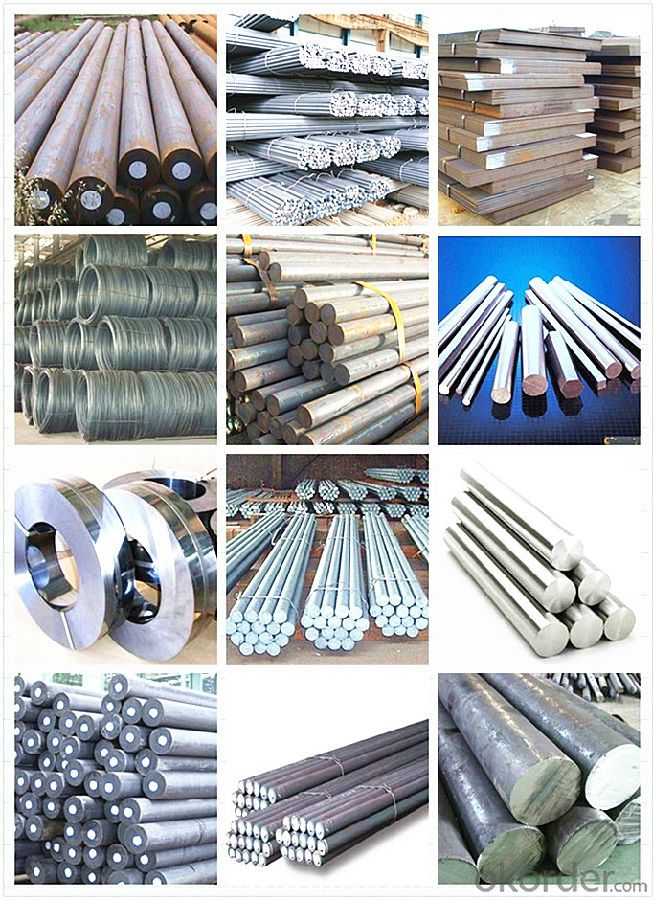
FAQ
Are you a trading company or manufacturer? | Manufacturer |
What’s the MOQ? | 3 metric ton |
What’s your delivery time? | 15-35 days after downpayment received |
Do you Accept OEM service? | Yes |
what’s your delivery terms? | FOB/CFR/CIF |
What's the Payment Terms? | 30% as deposit,70% before shipment by T/T |
Western Union acceptable for small amount. | |
L/C acceptable for large amount. | |
Scrow ,Paybal,Alipay are also ok | |
Why choose us? | Chose happens because of quality, then price, We can give you both. |
Additionally, we can also offer professional products inquiry, products knowledge train (for agents), smooth goods delivery, excellent customer solution proposals. | |
What's your available port of Shipment? | Main Port, China |
What’s your featured services? | Our service formula: good quality+ good price+ good service=customer's trust |
Where are your Market? | Covering more than 160 countries in the world |
- Q:How does special steel contribute to the renewable energy storage?
- Special steel plays a crucial role in renewable energy storage by enabling the construction of durable and efficient energy storage systems. It is used in the manufacturing of batteries, fuel cells, and other components, providing strength, corrosion resistance, and thermal stability. The high-quality properties of special steel help enhance the performance and longevity of renewable energy storage technologies, ensuring their reliability and contributing to the overall sustainability and viability of the renewable energy sector.
- Q:What are the different processes involved in making special steel?
- The different processes involved in making special steel include melting, refining, and alloying of the raw materials, followed by casting, rolling, and heat treatment to achieve the desired properties and composition.
- Q:How does special steel withstand extreme temperatures?
- Special steel is able to withstand extreme temperatures due to its unique composition and production process. One key factor is the addition of alloying elements such as chromium, molybdenum, and nickel, which enhance the steel's heat resistance. These elements form stable oxides on the surface of the steel, creating a protective barrier against oxidation and corrosion at high temperatures. Furthermore, special steel undergoes specialized heat treatment methods like quenching and tempering, which refine its microstructure and improve its mechanical properties. This process enhances the steel's ability to maintain its strength and hardness even when exposed to extreme temperatures. Additionally, the manufacturing process of special steel involves precision and control over the cooling rate during its production. This controlled cooling prevents the formation of brittle phases, ensuring that the steel retains its toughness and ductility at both high and low temperatures. Moreover, the grain size of special steel is carefully controlled through techniques like grain refinement, which leads to a more homogeneous and fine-grained microstructure. This fine-grained structure enhances the steel's resistance to thermal fatigue and creep, allowing it to withstand prolonged exposure to extreme temperatures without significant degradation. Overall, the combination of alloying elements, specialized heat treatment processes, controlled cooling, and refined microstructure makes special steel highly capable of withstanding extreme temperatures while maintaining its structural integrity and mechanical properties.
- Q:What are the different methods of measuring the hardness of special steel?
- Measuring the hardness of special steel can be done using various methods. These methods can be divided into two main categories: destructive and non-destructive testing. 1. One widely used destructive testing method is the Rockwell Hardness Test. This method measures the depth of penetration of an indenter into the steel surface. It provides a hardness value based on the steel's resistance to indentation. The Rockwell hardness test is a simple and quick method that requires minimal sample preparation. 2. Another destructive testing method is the Brinell Hardness Test. This method involves applying a known load to a hardened steel ball and measuring the diameter of the resulting indentation on the steel surface. The hardness value is determined based on the ratio of the applied load to the surface area of the indentation. 3. The Vickers Hardness Test is a micro-indentation test that uses a diamond pyramid-shaped indenter. It measures the diagonal length of the indentation left on the steel surface and calculates the hardness value based on the applied load. 4. The Knoop Hardness Test, similar to the Vickers test, is a micro-indentation method using a diamond pyramid-shaped indenter. However, instead of measuring the diagonal length of the indentation, it measures the length of the long axis. This test is particularly useful for measuring the hardness of thin steel samples or steel coatings. 5. For non-destructive testing, the Ultrasonic Hardness Test analyzes the propagation of ultrasonic waves through the steel to determine its hardness. The hardness value is determined based on the correlation between the velocity of the waves and the steel's hardness. 6. The Magnetic Hardness Test is another non-destructive testing method that utilizes magnetic properties. It involves applying a magnetic field to the steel and measuring the magnetic response. The hardness value is determined based on the correlation between the magnetic response and the steel's hardness. It's important to consider that each method has its own advantages and limitations. The choice of method depends on factors such as the type of steel, required accuracy, sample size, and available equipment and expertise.
- Q:How does special steel resist deformation under load?
- The unique composition and manufacturing techniques of special steel are specifically designed to prevent deformation under load. Its high strength is one of the key factors contributing to this resistance. Special steel is typically alloyed with elements like chromium, nickel, and molybdenum, which enhance its mechanical properties and make it stronger than regular steel. This increased strength allows the steel to bear heavier loads without significant deformation occurring. In addition, special steel often undergoes specialized heat treatment processes like quenching and tempering. These processes alter the steel's microstructure, resulting in a fine-grained structure and increased hardness. The fine-grained structure helps distribute the applied load more evenly, reducing the risk of localized deformation. Furthermore, special steel can exhibit exceptional toughness, meaning it can absorb a significant amount of energy before fracturing. Achieving this toughness involves carefully controlling the steel's chemical composition and manufacturing processes, such as controlling cooling rates during heat treatment. The ability to absorb energy without undergoing deformation further enhances its resistance to load-induced deformation. Moreover, special steel can possess superior fatigue resistance, allowing it to withstand repeated loading and unloading cycles without deformation. This is achieved by eliminating impurities and controlling the steel's grain structure, reducing the initiation and propagation of cracks that can lead to deformation. In conclusion, the combination of high strength, fine-grained structure, toughness, and fatigue resistance in special steel enables it to resist deformation under heavy loads. These characteristics are meticulously engineered and optimized during the manufacturing process to ensure that the steel can withstand intended applications and loads without significant deformation occurring.
- Q:How does special steel contribute to the heat resistance of products?
- Special steel contributes to the heat resistance of products due to its unique properties and composition. It is specifically designed to withstand high temperatures without losing its strength or structural integrity. The inclusion of elements such as chromium, nickel, and molybdenum in special steel enhances its heat resistance by forming a protective oxide layer that prevents oxidation and corrosion at elevated temperatures. This enables products made with special steel to withstand extreme heat conditions, making them suitable for various applications in industries such as aerospace, automotive, and energy.
- Q:What are the different production methods for special steel?
- There are several different production methods for special steel, each with its own unique advantages and characteristics. Some of the most common methods include: 1. Electric Arc Furnace (EAF): This method involves melting scrap steel in an electric arc furnace, where an electric current generates intense heat to melt the materials. EAF is popular for its flexibility, as it can produce a wide range of steel grades and alloys. 2. Basic Oxygen Furnace (BOF): In this process, molten iron from a blast furnace is combined with scrap steel and oxygen to remove impurities and adjust the carbon content. BOF is known for its high production capacity and ability to produce large quantities of steel. 3. Vacuum Induction Melting (VIM): VIM is a method used to produce high-quality and high-purity steel. It involves melting the raw materials in a vacuum environment to prevent contamination and achieve precise control over the alloy composition. 4. Continuous Casting: This method involves pouring molten steel into a water-cooled mold, which continuously produces solidified steel slabs, blooms, or billets. Continuous casting is known for its efficiency and ability to produce consistent and defect-free steel products. 5. Powder Metallurgy: This technique involves compacting and sintering metal powders to produce steel with specific properties. Powder metallurgy allows for the production of complex shapes, improved mechanical properties, and the incorporation of alloying elements that are challenging to achieve through traditional methods. 6. Additive Manufacturing (AM): Also known as 3D printing, AM is a relatively new method for producing special steel. It involves layer-by-layer deposition of metal powders, which are then fused together using heat or a laser. AM offers great design freedom, the ability to produce complex geometries, and the potential for customized steel parts. Each production method has its own advantages and limitations, and the choice depends on factors such as the desired steel properties, production volume, cost considerations, and the specific requirements of the end-use application.
- Q:How does special steel perform in high-stress corrosion cracking environments?
- Special steel is specifically designed to perform well in high-stress corrosion cracking environments. This type of steel is highly resistant to corrosion and can withstand the combination of stress and corrosive elements present in these environments. Its unique composition and manufacturing process make it more durable and less prone to cracking, ensuring its reliable performance in such challenging conditions.
- Q:How does special steel contribute to reducing product waste during manufacturing?
- Special steel contributes to reducing product waste during manufacturing in several ways. Firstly, special steel is known for its high strength and durability, which means that products made from this material are less likely to break or fail during the manufacturing process. This reduces the number of defective or damaged products that would otherwise be discarded as waste. Secondly, special steel can be fabricated to precise specifications, allowing manufacturers to create parts with tight tolerances and minimal material wastage. This ensures that the raw materials are utilized efficiently, minimizing waste during production. Additionally, special steel can be recycled and reused, reducing the need for new raw materials and further minimizing product waste. Overall, the use of special steel in manufacturing processes helps to improve product quality, reduce material wastage, and promote sustainable practices.
- Q:What are the different methods of improving the strength of special steel?
- There are several methods that can be employed to improve the strength of special steel. One common method is through the process of alloying. By adding certain elements to the steel, such as manganese, chromium, or vanadium, the strength and hardness of the steel can be significantly increased. These alloying elements form strong and stable compounds with the steel, enhancing its overall strength. Another method is through heat treatment. This involves subjecting the steel to controlled heating and cooling processes to alter its microstructure. For instance, quenching and tempering can be used to increase the strength and hardness of the steel by creating a hardened martensitic structure. Precipitation hardening is another heat treatment technique which involves the formation of fine particles within the steel matrix, resulting in improved strength. Cold working is also a widely used method for strengthening special steel. By subjecting the steel to plastic deformation at low temperatures, its grain structure becomes elongated and dislocations are introduced. This leads to an increase in strength and hardness of the steel. Additionally, surface treatments can be applied to improve the strength of special steel. For example, carburizing or nitriding can be used to introduce carbon or nitrogen into the surface layer of the steel, forming a hard and wear-resistant surface. Furthermore, advancements in metallurgical technology have introduced techniques such as powder metallurgy and rapid solidification. These methods involve the production of steel with fine and homogeneous microstructures, resulting in improved strength and performance. Overall, the methods of improving the strength of special steel include alloying, heat treatment, cold working, surface treatments, and advanced metallurgical technologies. These techniques can be tailored to meet specific requirements, enabling the production of high-strength and high-performance steel for various applications.
1. Manufacturer Overview |
|
|---|---|
| Location | |
| Year Established | |
| Annual Output Value | |
| Main Markets | |
| Company Certifications | |
2. Manufacturer Certificates |
|
|---|---|
| a) Certification Name | |
| Range | |
| Reference | |
| Validity Period | |
3. Manufacturer Capability |
|
|---|---|
| a)Trade Capacity | |
| Nearest Port | |
| Export Percentage | |
| No.of Employees in Trade Department | |
| Language Spoken: | |
| b)Factory Information | |
| Factory Size: | |
| No. of Production Lines | |
| Contract Manufacturing | |
| Product Price Range | |
Send your message to us
Equal-Unequal Grade CNBM Black & Galvanized Steel Angle Bar
- Loading Port:
- Tianjin
- Payment Terms:
- TT OR LC
- Min Order Qty:
- 3 m.t.
- Supply Capability:
- 10000 m.t./month
OKorder Service Pledge
OKorder Financial Service
Similar products
New products
Hot products
Related keywords
